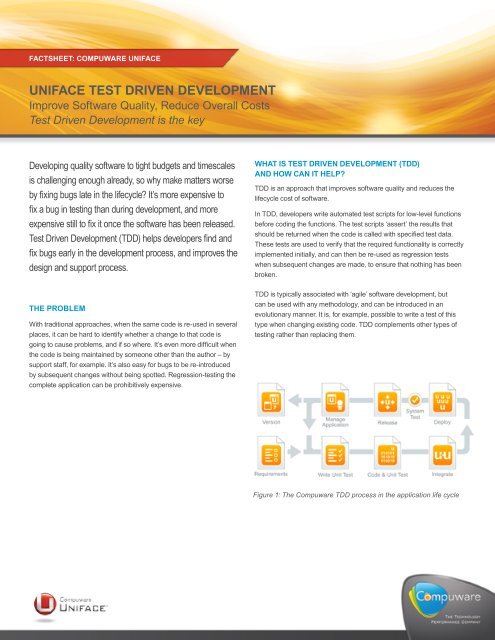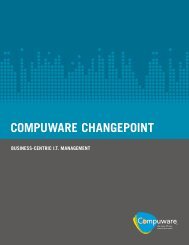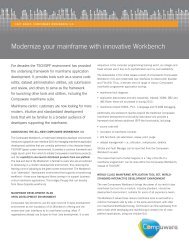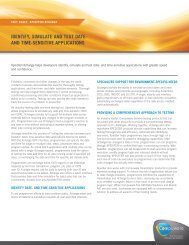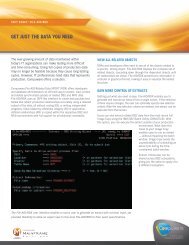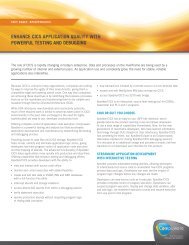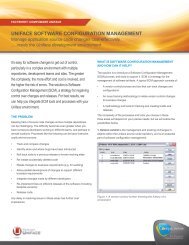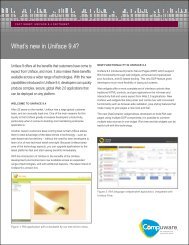UNIFACE TEST DRIVEN DEVELOPMENT - Compuware Corporation
UNIFACE TEST DRIVEN DEVELOPMENT - Compuware Corporation
UNIFACE TEST DRIVEN DEVELOPMENT - Compuware Corporation
Create successful ePaper yourself
Turn your PDF publications into a flip-book with our unique Google optimized e-Paper software.
FACTSHEET: COMPUWARE <strong>UNIFACE</strong><br />
<strong>UNIFACE</strong> <strong>TEST</strong> <strong>DRIVEN</strong> <strong>DEVELOPMENT</strong><br />
Improve Software Quality, Reduce Overall Costs<br />
Test Driven Development is the key<br />
Developing quality software to tight budgets and timescales<br />
is challenging enough already, so why make matters worse<br />
by fixing bugs late in the lifecycle? It’s more expensive to<br />
fix a bug in testing than during development, and more<br />
expensive still to fix it once the software has been released.<br />
Test Driven Development (TDD) helps developers find and<br />
fix bugs early in the development process, and improves the<br />
design and support process.<br />
THE PROBLEM<br />
With traditional approaches, when the same code is re-used in several<br />
places, it can be hard to identify whether a change to that code is<br />
going to cause problems, and if so where. It’s even more difficult when<br />
the code is being maintained by someone other than the author – by<br />
support staff, for example. It’s also easy for bugs to be re-introduced<br />
by subsequent changes without being spotted. Regression-testing the<br />
complete application can be prohibitively expensive.<br />
WHAT IS <strong>TEST</strong> <strong>DRIVEN</strong> <strong>DEVELOPMENT</strong> (TDD)<br />
AND HOW CAN IT HELP?<br />
TDD is an approach that improves software quality and reduces the<br />
lifecycle cost of software.<br />
In TDD, developers write automated test scripts for low-level functions<br />
before coding the functions. The test scripts ‘assert’ the results that<br />
should be returned when the code is called with specified test data.<br />
These tests are used to verify that the required functionality is correctly<br />
implemented initially, and can then be re-used as regression tests<br />
when subsequent changes are made, to ensure that nothing has been<br />
broken.<br />
TDD is typically associated with ‘agile’ software development, but<br />
can be used with any methodology, and can be introduced in an<br />
evolutionary manner. It is, for example, possible to write a test of this<br />
type when changing existing code. TDD complements other types of<br />
testing rather than replacing them.<br />
Figure 1: The <strong>Compuware</strong> TDD process in the application life cycle
WHAT IS <strong>TEST</strong> <strong>DRIVEN</strong> <strong>DEVELOPMENT</strong> (TDD)<br />
AND HOW CAN IT HELP? (Continued)<br />
The TDD approach has a number of benefits:<br />
• It results in better design, as the process of creating tests helps<br />
the developer to decide how best to implement the code<br />
• The tests document the code behavior, as they are an up-to-date<br />
record of expected results when calling the code with given test<br />
data<br />
• Breaking changes are identified early, and are more likely to be<br />
fixed prior to acceptance testing<br />
• The developer thinks about failure scenarios in advance, and, by<br />
documenting them in the form of tests, ensures that they are not<br />
forgotten<br />
• The underlying cause of runtime problems can be identified more<br />
easily.<br />
The screenshot below shows the interactive test runner with some<br />
errors that the developer is working on. When the code is fixed, the<br />
developer will re-run tests and should see green ticks indicating that<br />
the code is working correctly.<br />
Figure 1: Interactive test runner.<br />
<strong>Compuware</strong> <strong>Corporation</strong>, the technology performance company, provides software, experts and best practices to ensure<br />
technology works well and delivers value. <strong>Compuware</strong> solutions make the world’s most important technologies perform<br />
at their best for leading organizations worldwide, including 46 of the top 50 Fortune 500 companies and 12 of the top 20<br />
most visited U.S. web sites. Learn more at: compuware.com.<br />
<strong>Compuware</strong> <strong>Corporation</strong> World Headquarters • One Campus Martius • Detroit, MI 48226-5099<br />
REFACTORING AND TDD<br />
© 2011 <strong>Compuware</strong> <strong>Corporation</strong><br />
<strong>Compuware</strong> products and services listed within are trademarks or registered trademarks of <strong>Compuware</strong> <strong>Corporation</strong>.<br />
Oracle and Java are registered trademarks of Oracle and/or its affiliates. Other names may be trademarks of their<br />
respective owners.<br />
12.10<br />
During both development and maintenance, it makes sense to re-use<br />
existing code wherever possible. ‘Refactoring’ is the term used for the<br />
process of re-organizing code so that it performs well when re-used.<br />
The process also creates an elegant interface to facilitate re-use.<br />
COMPUWARE CAN HELP YOU IMPLEMENT TDD<br />
If you’re thinking of adopting TDD, it makes sense to talk to <strong>Compuware</strong><br />
Uniface. We can provide a service that includes the following:<br />
• Test runner software, as shown above<br />
• A framework for writing and running tests with assertions<br />
• Experienced consultants who can share knowledge of best<br />
practices<br />
• Test framework documentation<br />
• Low-cost implementation (typically only a 2-day engagement is<br />
required).<br />
In addition, you get to keep the source code for the test framework and<br />
test runner, so you can customize the solution if required.<br />
COMPLEMENTARY OFFERINGS<br />
When our TDD approach is combined with Continuous Integration<br />
(see separate fact sheet), all your tests can be re-run automatically<br />
whenever someone makes a change. That gives you extra confidence<br />
that changes aren’t breaking other parts of the system, and makes it<br />
easy to build releases on demand.<br />
If you’d like to know more about TDD, or about our products and<br />
services in this area, <strong>Compuware</strong> Uniface Services can help.<br />
E-mail: askuniface@compuware.com<br />
Tel: +44 (0)1628 611000<br />
To learn more, visit: www.uniface.com


